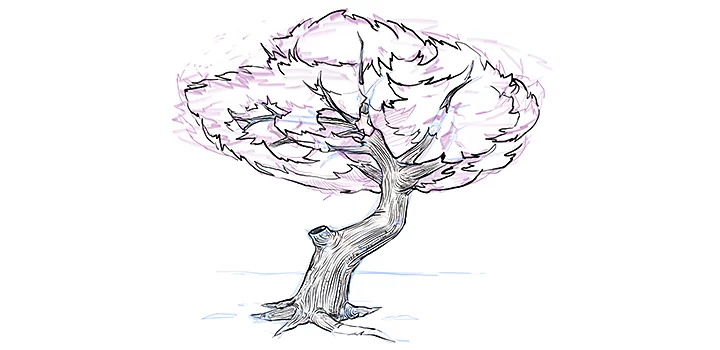How to Draw a Tree: A Step-by-Step Guide
Trees are a fundamental element in art and design, representing nature, providing shade, and adding depth and interest to a composition. Learning how to draw trees can be a valuable skill for artists of all levels, from beginners to professionals. In this comprehensive guide, we will explore the basic techniques and steps to draw a tree, covering various styles and perspectives.
Understanding Tree Structure
Before diving into the drawing process, it’s essential to understand the basic structure of a tree. A tree consists of several key elements:
- Trunk: The main vertical support of the tree, which extends from the roots to the branches.
- Branches: The lateral extensions of the trunk that support the leaves and twigs.
- Leaves: The green, flat structures that grow on the branches and perform photosynthesis.
- Roots: The underground part of the tree that anchors it to the ground and absorbs water and nutrients.
By understanding these elements, you can create more realistic and visually appealing tree drawings.
Drawing a Tree from the Side View
- Sketch the trunk: Begin by drawing a vertical line for the trunk, tapering it towards the top to create the illusion of depth.
- Add the branches: Draw the main branches extending from the trunk at various angles. Use curved lines to create a natural, organic look.
- Sketch the secondary branches: Add smaller branches extending from the main branches, creating a more detailed and realistic tree.
- Draw the leaves: Depending on the tree type, draw the leaves using various shapes and sizes. For example, oak leaves can be drawn as ovals with jagged edges, while maple leaves have a distinct five-pointed shape.
- Refine and add details: Erase any unnecessary lines and add shadows, highlights, and textures to create depth and dimension in your drawing.
Drawing a Tree from the Front View
- Sketch the trunk: Draw a vertical line for the trunk, making it wider at the bottom and narrower at the top.
- Add the main branches: Draw the main branches extending from the trunk in a symmetrical or asymmetrical pattern, depending on the tree type.
- Sketch the secondary branches: Add smaller branches extending from the main branches, creating a more detailed and realistic tree.
- Draw the leaves: Use various shapes and sizes to create the leaves, considering the tree type and the angle of the branches.
- Refine and add details: Erase any unnecessary lines and add shadows, highlights, and textures to create depth and dimension in your drawing.
Drawing a Tree from the Three-Quarter View
- Sketch the trunk: Draw the trunk at an angle, making it wider at the bottom and narrower at the top.
- Add the main branches: Draw the main branches extending from the trunk at various angles, creating a sense of depth and perspective.
- Sketch the secondary branches: Add smaller branches extending from the main branches, creating a more detailed and realistic tree.
- Draw the leaves: Use various shapes and sizes to create the leaves, considering the tree type and the angle of the branches.
- Refine and add details: Erase any unnecessary lines and add shadows, highlights, and textures to create depth and dimension in your drawing.
Drawing Different Tree Types
While the basic steps for drawing a tree remain the same, different tree types have unique characteristics that can be incorporated into your drawings:
- Oak trees: Characterized by their thick, gnarled trunks and rounded, lobed leaves.
- Pine trees: Featuring needle-like leaves and a triangular shape.
- Cherry blossoms: Known for their delicate, pink flowers and slender branches.
- Palm trees: Distinctive for their tall, straight trunks and fan-shaped leaves.
By studying the unique features of various tree types, you can create more diverse and interesting tree drawings.
Frequently Asked Questions (FAQ)
Q1: What are the basic elements of a tree?
A1: The basic elements of a tree are the trunk, branches, leaves, and roots. Understanding these elements is crucial for creating realistic tree drawings.
Q2: How do I draw a tree from the side view?
A2: To draw a tree from the side view, start with the trunk, add the main branches, sketch the secondary branches, draw the leaves, and refine the details.
Q3: How do I draw a tree from the front view?
A3: To draw a tree from the front view, begin with the trunk, add the main branches in a symmetrical or asymmetrical pattern, sketch the secondary branches, draw the leaves, and refine the details.
Q4: How do I draw a tree from the three-quarter view?
A4: To draw a tree from the three-quarter view, start with the angled trunk, add the main branches at various angles, sketch the secondary branches, draw the leaves, and refine the details.
Q5: Where can I find more information about drawing trees?
A5: For more detailed information about drawing trees, you can visit the Wikipedia page on tree drawing here.
Conclusion
Drawing trees is a rewarding and enjoyable skill that can be mastered with practice and patience. By understanding the basic structure of a tree and applying the techniques outlined in this guide, you can create beautiful and realistic tree drawings from various perspectives and in different styles. Remember to experiment, observe nature, and most importantly, have fun with the process!



